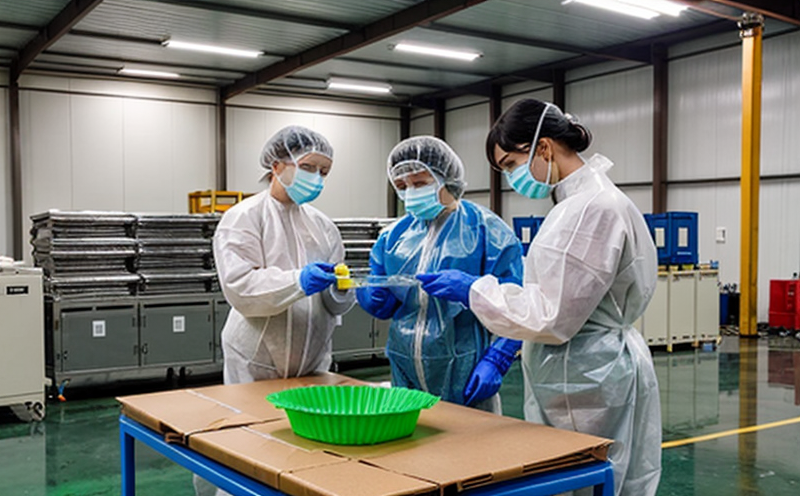ISO 15105-3 Gas Barrier Testing for Plastic Bottles
The ISO 15105 series of standards is widely recognized as a comprehensive set of guidelines designed to ensure the integrity and quality of packaging materials, particularly focusing on their gas barrier properties. The third part of this standard specifically addresses the testing of plastic bottles for gas permeability, which is critical in maintaining product freshness, shelf life, and compliance with regulatory requirements.
The process involves subjecting a specimen cut from the bottle to controlled conditions where it is exposed to specific gases under defined temperature and humidity levels. The rate at which these gases pass through the material is then measured using precision instruments. This method allows for accurate quantification of gas barrier performance, ensuring that packaging meets both internal quality control standards and external regulatory expectations.
For plastic bottles, this testing is crucial because even minor breaches in gas integrity can lead to significant issues such as spoilage, loss of product efficacy, or contamination. By adhering strictly to ISO 15105-3 guidelines, manufacturers can ensure their products remain safe and effective throughout the supply chain.
The testing procedure typically involves several key steps: selecting an appropriate specimen size from the bottle, placing it in a controlled environment chamber, exposing it to specified gas mixtures, measuring the permeation rates over time, and analyzing results against set criteria. Compliance with this standard not only enhances product quality but also supports broader sustainability goals by optimizing resource use and minimizing waste.
Accurate and consistent testing is vital for maintaining trust within supply chains and ensuring adherence to global standards like ISO 15105-3. With precise measurements, manufacturers can confidently meet regulatory demands while improving overall operational efficiency.
Industry Applications
| Industry Sector | Application |
|---|---|
| Beverage Industry | Ensuring carbonation retention and preventing oxidation in carbonated beverages. |
| Pharmaceuticals | Maintaining the stability of drug formulations by preserving moisture barriers. |
| Foods & Beverages | Avoiding spoilage due to oxygen ingress or moisture loss in food packaging. |
| Personal Care Products | Preserving active ingredients and extending shelf life of cosmetics and toiletries. |
| Fine Chemicals | Protecting reactive compounds from degradation by controlling gas exchange. |
| Consumer Electronics | Preventing moisture ingress that can damage sensitive components in electronic devices. |
The versatility of ISO 15105-3 makes it applicable across numerous industries where maintaining the integrity of packaging against gas permeation is essential. This standard helps to ensure product quality, extend shelf life, and maintain compliance with international standards.
Quality and Reliability Assurance
Implementing ISO 15105-3 gas barrier testing for plastic bottles is integral to maintaining high-quality products that meet stringent regulatory standards. This testing ensures consistent performance across batches, supports continuous improvement initiatives, and builds consumer trust through reliable product quality.
The rigorous nature of the test guarantees that each bottle meets specified permeability limits, thereby preventing potential issues like off-flavors or compromised efficacy in pharmaceuticals. By adhering to this standard, companies can demonstrate compliance with relevant regulations such as FDA guidelines for food contact materials and EU directives regarding packaging safety.
Moreover, regular testing helps identify any variations in production processes that could affect gas barrier properties. Early detection of these issues allows for timely adjustments, preventing costly recalls or product rejections downstream. This proactive approach enhances overall operational efficiency by reducing waste and improving resource utilization.
The reliability assurance provided by ISO 15105-3 is particularly beneficial when dealing with complex supply chains involving multiple stakeholders. It ensures that all parties involved are working towards the same goal of maintaining superior product quality, which ultimately leads to increased customer satisfaction and loyalty.
Competitive Advantage and Market Impact
In today's competitive market, where consumers are increasingly concerned about product safety and environmental impact, having robust quality assurance measures is crucial. ISO 15105-3 gas barrier testing for plastic bottles gives businesses a clear advantage by providing evidence of consistent adherence to global standards.
Companies that invest in this type of testing can position themselves as leaders in terms of product integrity and sustainability practices. This commitment translates into enhanced brand reputation, which can drive sales growth and customer retention rates. Additionally, it opens doors to new markets where stringent regulatory requirements are enforced but may be lacking locally produced alternatives.
From a business perspective, meeting these standards demonstrates leadership capabilities within the industry and fosters long-term relationships with key partners including suppliers, distributors, and retailers. It also helps attract investors who value ethical practices aligned with international norms.
The environmental benefits of using this testing method further bolster its appeal to eco-conscious consumers who are seeking sustainable solutions. By reducing waste generation associated with compromised packaging, companies adopting ISO 15105-3 contribute positively towards global sustainability goals.





